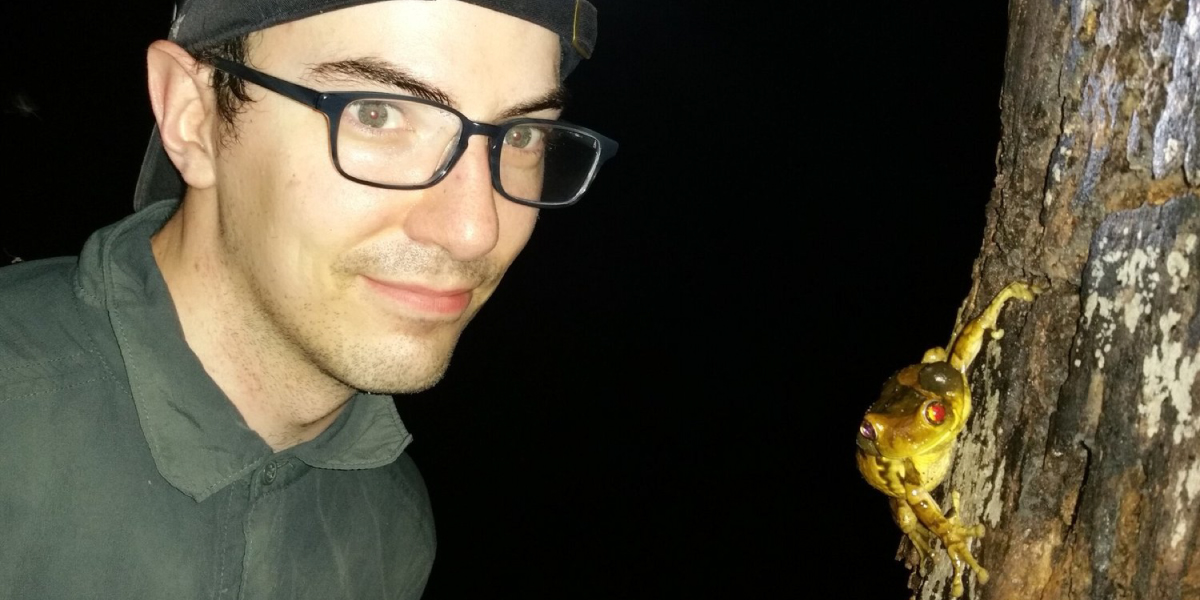When Defense Becomes a Signal: Purdue Research Reveals How Frogs Balance Attraction and Survival
11-14-2025

What if the very call that makes someone stand out also puts them in danger?
In nature, communication doesn’t happen in a vacuum- every display might draw an admirer and an unwelcome eavesdropper.
When it comes to finding a mate, standing out can be risky business. A new study led by Purdue University researchers shows that for one small tropical frog, the same movements that help fend off parasites can also change how attractive a male appears to potential mates- and even influence how predators find them.
The research, led by Brian Leavell, a former Purdue PhD student in Professor Ximena Bernal’s lab, examines how animals navigate a complex web of communication, competition, and danger. Leavell worked with Research Associate Hoover Pantoja-Sánchez and collaborators from the Smithsonian Tropical Research Institute, where Bernal also serves as a research associate.
Their paper, “Variation in sexual signals and defensive strategies elicits receiver-dependent shifts in attractiveness,” was recently published in The Journal of Experimental Biology.
The cost of being heard
Male túngara frogs are known for their distinctive mating calls, which help them attract females in the dense rainforests of Panama. But these calls also have an unintended audience- blood-sucking midges that home in on the sound to find their next meal.
“When midges bite, the frogs often swat at them,” Leavell explained. “Those defensive movements create ripples on the water’s surface. Our study shows that those ripples can actually change how females respond to the males’ calls.”
In other words, a frog’s attempts to defend itself may alter how appealing it seems to a potential mate.
A signal caught in the middle
By recording and analyzing the reactions of both female frogs and predatory bats, the team found that a male’s attractiveness depends on the combination of his calling behavior and how vigorously he defends himself from parasites.
When males called more frequently but swatted less, they were more appealing to females. However, when those same calls were paired with frequent swatting, female interest declined. Interestingly, the predator’s response didn’t always match the females’- bats were drawn to different combinations of calls and movements.
“This study highlights that communication in the wild is rarely one-on-one,” Bernal said. “Signals meant for mates can also be intercepted by unwanted receivers, such as parasites or predators. Understanding those dynamics helps explain why so much variation in animal behavior persists.”
Seeing the bigger picture
Leavell’s research focuses on how perception shapes communication and behavior in animals. He uses the túngara frog system to explore how seemingly small details- like a defensive movement- can ripple through an entire ecological network.
“Swatting at a mosquito is something we can all relate to,” he said. “But for these frogs, that same motion can change who notices them- and that can mean the difference between attracting a mate or attracting a predator.”
Bernal’s lab studies the evolution of communication systems and predator-prey interactions, often combining behavioral experiments with field observations in Central America. Their work contributes to a broader understanding of how animals balance the need to communicate with the need to survive.
The broader impact
By revealing how one simple behavior can influence both mating success and predation risk, this research offers insight into the complex relationships that shape evolution and behavior. It serves as a reminder that even small actions can have cascading effects across ecosystems- a lesson that resonates far beyond the forest floor.
The study was supported by the National Science Foundation, the Smithsonian Tropical Research Institute, and Purdue University.
About the Department of Biological Sciences at Purdue University
The Department of Biological Sciences is the largest life sciences department at Purdue University. As part of Purdue One Health, we are dedicated to pioneering scientific discoveries and transformative education at the cutting edge of innovation. From molecules to cells, from tissues to organisms, from populations to ecosystems- we bring together multiple perspectives, integrating across biological scales to advance our understanding of life and tackle the world’s most pressing challenges. Learn more at bio.purdue.edu.
Written by: Alisha Willett, Communications Specialist, amwillet@purdue.edu
Contributors: Brian Leavell, brianleavell1@gmail.com
Ximena Bernal, xbernal@purdue.edu